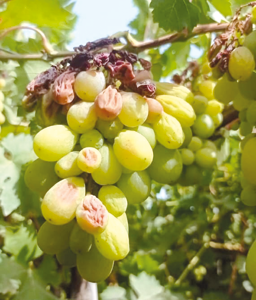You are here
Agriculture sector withers as heatwave continues
By Rayya Al Muheisen - Aug 14,2023 - Last updated at Aug 14,2023

Withered grapes are seen at a farm in this recent photo (Photo courtesy of Islam Farahat Facebook page)
AMMAN — The recent heatwave is projected to have a negative impact on the agricultural sector, affecting crops, livestock, water resources and overall food production.
The unprecedented heatwave affecting Jordan has resulted in a “skyrocketing” electricity demand and an increase in water demand by 30 per cent, according to the Ministry of Water’s spokesperson, Omar Salameh.
However, the agricultural sector suffers the worst consequences, according to the Jordan Valley Farmers Union.
Adnan Khaddam, president of the union, told The Jordan Times that the most prominent issues the agricultural sector might face are water scarcity and droughts.
“Heatwaves often exacerbate drought conditions by increasing evaporation rates and depleting soil moisture,” Khaddam said, explaining that increased evaporation leads to extreme irrigation water scarcity, negatively impacting crop growth and yield.
In Jordan, where water resources are already limited, heatwaves further impact water availability for both the agriculture industry and households, said Khaddam.
“Extreme heatwaves disrupt traditional planting and harvesting schedules, which mostly affect grape, tomato and fig crops,” Khaddam highlighted.
Khaddam stated that this issue causes heat-related damage to crops, including sunburn, scorching and wilting.
“Young and sensitive crops are particularly vulnerable. In some cases, the damage can be so severe that entire crops may be lost,” said Khaddam.
Za’al Kawaleet, president of Livestock Owners and Breeders Association, told The Jordan Times that livestock breeders are exhausting all resources to mitigate the negative impacts of heatwaves.
“The most affected livestock are lambs and calves; extreme heat increases the mortality rate of young animals,” Kawaleet added.
He highlighted that high temperatures lead to increased respiratory rates in livestock as they attempt to dissipate heat.
“This can exacerbate respiratory issues in animals and make them more susceptible to respiratory diseases,” said Kawaleet.
Prolonged heat stress can lead to exhaustion, reduced feed intake, dehydration, and even death in extreme cases, he added.
Kawaleet said that reduced feed intake further leads to reduced growth rates and decreased milk production.
“Farmers may need to invest in additional infrastructure to provide adequate shelters, ventilation and cooling mechanisms for their livestock to mitigate the effects of heatwaves,” Kawaleet said.
Investing in water and shelter cooling technology poses a financial burden for many farmers, especially small- and medium-scale breeders.
High temperatures during heatwaves cause excessive evaporation and transpiration, stressing the crops and leading to water loss, and eventually crop damage and loss, which reduces natural livestock feed.
“Reduced natural feed poses additional financial constraints on livestock breeders,” he concluded, stressing that the current heatwave has led to an overall increase in water demand for livestock.
Related Articles
AMMAN – Farmers and livestock breeders are urged to take precautionary measures to protect their cattle and crops as a hot spell is expected
AMMAN — The recent heatwave that has impacted the Kingdom since the end of August has affected farmers and caused them more losses and suffe
AMMAN — Livestock owners and breeders are growing concerned over potential ramifications that the ongoing conflict in Sudan may have on the














